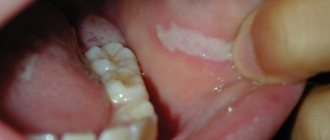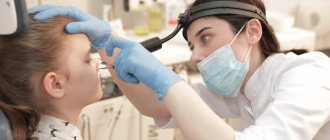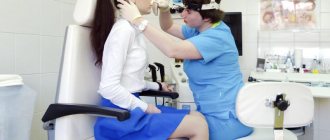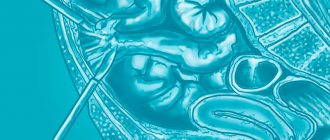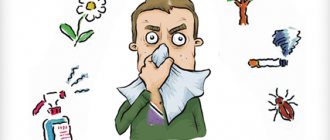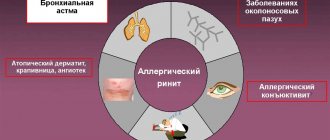Exposure to adverse environmental factors, frequent infectious diseases, bad habits, surgery and household injuries are the causes that lead to inflammation and destruction of the nasal mucosa. As a result of these processes, a complex chronic disease develops - atrophic rhinitis. If proper treatment is not provided, this pathology can lead to serious complications.
What are the symptoms of atrophic rhinitis? What methods of productive treatment of the disease exist? You will find answers to these and many other questions in our article.
What is atrophic rhinitis?
Atrophic rhinitis is a long-term inflammatory disease of the nasal mucosa, accompanied by its thinning. Main signs of the disease:
- increased dryness of the nasopharynx,
- viscous discharge of yellow or green color,
- the appearance of specific crusts,
- short-term bleeding.
Over time, most of the structure of the nose is affected: nerve endings, blood vessels, bone tissue. The disease affects adults, mainly women, and children, most often teenagers. However, sometimes atrophic rhinitis is detected in a child in early childhood (from 1 year).
An alternative name for chronic atrophic rhinitis is “dry” runny nose. This is explained by scanty secretions with severe breathing problems.
The disease is divided into two types:
- Primary.
It forms independently; the causes have not been identified to date. - Secondary.
Appears as a consequence of concomitant pathologies or surgical interventions.
Timely detection and subsequent treatment of atrophic rhinitis is extremely important because the disease quickly becomes chronic. If the mucous membranes do not perform protective and thermoregulatory functions, the functioning of most respiratory organs will be disrupted.
Diagnosis of rhinitis
To make a diagnosis, a clinical examination by a specialist with rhinoscopy is sufficient.
To assess the general condition of the patient, a general blood test, fluoroscopy of the nasal cavity and paranasal sinuses are performed. To confirm allergic rhinitis, a consultation with an allergist is necessary. Skin tests are prescribed to determine the following types of allergens:
- household: house dust, mites, molds, hair and epithelium of pets;
- plant: pollen of trees and weeds;
- food: vegetables, fruits and citrus fruits, legumes, melons, nuts, fish and seafood, meat, cereals, sesame seeds, baby formula.
In young children, identifying allergic rhinitis is difficult, since parents first begin to treat the child for an inflammatory disease.
If an infection is suspected, tests are performed to detect the RNA of influenza viruses, evaluate the level of immunoglobulins, and also examine smears from the nasal mucosa (rhinocytogram), nasal sinuses or oropharynx, and sputum samples.
In some cases, additional diagnostics are carried out: CT scan of the nasal sinuses, endoscopy of the nasal cavity, rhinopneumometry, cytological examination of the nasal mucosa, biochemical blood test.
Reasons for the development of the disease
We list the common causes that contribute to the occurrence of the disease:
- Heredity: often the disease is passed on from generation to generation.
- Repeated viral or bacterial infections contribute to atrophy of the nasal mucosa.
- Hormonal imbalances, such as endocrine system disorders, that occur in a teenager's body during puberty.
- Trauma and surgery.
- Lack of vitamin D and iron in the body.
- Impact of stress factors.
- Harmful environmental conditions:
- tobacco smoke,
- chemical vapors
- dust and smoke in the air,
- prolonged inhalation of hot or cold air.
Long-term use of vasoconstrictor drops can also cause atrophic rhinitis.
It should be noted that identifying a specific cause that provoked the disease increases the effectiveness of treatment.
Treatment of hypertrophic rhinitis
Comprehensive treatment of chronic hypertrophic rhinitis is necessary, including non-drug methods, physiotherapy, medication and surgery.
The patient is advised to exclude spicy, hot foods from the diet and limit easily digestible carbohydrates (sweets). Breathing exercises are useful, improving the function of the glands of the mucous membrane.
Endonasal physiotherapeutic techniques are used: UHF, ultraviolet irradiation, laser therapy, electrophoresis with solutions of zinc sulfate or calcium chloride.
For mild hypertrophy, sclerotherapy is prescribed: glucocorticoid hormones are injected into the inferior nasal concha (under its mucosa), the course consists of 8–10 procedures. It is possible to cauterize the hypertrophied mucosa with silver nitrate and other chemicals.
If the above methods are ineffective, surgical treatment of hypertrophic rhinitis is used. Various types of surgical interventions are used for this:
- submucosal disintegration (destruction) of the inferior turbinates using ultrasound;
- submucosal vasotomy, that is, destruction of areas of the choroid plexuses feeding the inferior turbinates;
- lower conchotomy (removal of the posterior section) using a gentle technique, accompanied by preservation of the anterior turbinates;
- endoscopic osteoconchotomy under microscopic control;
- lateroconchopexy - displacement of the concha to widen the nasal passages.
At the same time, the shape of the nasal septum can be corrected if it is bent.
The choice of the method of operation is made by the doctor, taking into account the clinical picture and severity of the disease. The criterion for successful treatment is the restoration of free nasal breathing, the disappearance of other complaints, and an improvement in the patient’s quality of life.
Main symptoms of atrophic rhinitis
The progression of the disease leads to a significant deterioration in a person’s condition and a decrease in quality of life. This pathology is accompanied by the following manifestations:
- heavy breathing and nasal congestion;
- scanty viscous discharge from the nasal cavity;
- feeling of dryness and burning;
- the appearance of crusts, when removed, bleeding occurs;
- decreased sense of smell up to complete disappearance;
- insomnia;
- lack of appetite;
- hearing impairment.
During the examination, the otolaryngologist will notice characteristic deviations from the normal state of the nasal mucosa, which will acquire a pale pink color, its structure will become dry and dull with yellow-green crusts.
If you start atrophic rhinitis, it can develop into ozena - a foul runny nose. The extreme stages of the atrophic process are characterized by:
- thinning of the mucous membrane,
- reduction in the number of cells,
- damage to the nervous system.
The following pathological processes occur in the nasal cavity:
- ciliated tissue is converted into flat tissue,
- blood vessels become inflamed,
- bone tissue is replaced by fibrous tissue.
A deformation of the nose occurs; its shape begins to resemble a duck’s. This disease is considered severe and requires immediate treatment.
In this table we consider the symptoms of various types of atrophic rhinitis.
| Type of rhinitis | Symptoms |
| Simple atrophic rhinitis |
|
| Subatrophic rhinitis | The nutrition of the nasal mucosa is impaired, it dries out and crusts form on it. Patients are bothered by burning and itching in the nasopharynx, and olfactory sensitivity worsens. |
| Infectious atrophic rhinitis |
Also characteristic are the following symptoms:
With further development of the pathology, asymmetry of the jaw and deformation of the nasal septum appear. |
| Ozena | Feeling of painful dryness and the presence of a foreign body in the nasal cavity, although breathing is free. Crusts appear that have a putrid odor. The stench from the nose is so strong that others try to avoid the presence of the patient. There is also a sharp decrease or absence of sense of smell, tinnitus and hearing loss |
Symptoms of rhinitis
According to the severity of symptoms, the following stages of acute rhinitis are distinguished:
- mild: lasts from several hours to 2 days, accompanied by discomfort in the nose and signs of malaise (chills, headache, temperature up to 37.5 C);
- medium: symptoms increase, clear discharge appears, nasal breathing is disrupted, lacrimation and sneezing, nasal congestion, headache, tinnitus appear;
- severe: purulent-mucous yellowish and greenish discharge is noted, while the general condition may improve, nasal breathing becomes easier.
The acute course of the disease lasts from 7 to 12 days.
Rhinitis is most severe in newborns due to the narrowness of the nasal passages and the inability to blow their nose.
Possible complications of the disease
Prolonged ignoring of pathology leads to serious complications:
- anosmia - partial or complete loss of smell;
- decreased local immunity;
- inflammation of the trachea, larynx, ears, eyeballs;
- deterioration of memory and intelligence;
- hearing problems;
- nasal deformity;
- pneumonia;
- meningitis;
- gastrointestinal dysfunction: nausea, vomiting, dyspepsia, gastritis;
- depressive states, apathy, neurasthenia.
The most difficult consequence of pathology is the spread of the atrophic process to other organs.
Unfortunately, people often turn to an otolaryngologist with an already advanced form of atrophic dry rhinitis. The doctor prescribes treatment that can make the patient feel better and stop the development of the pathology, but it is no longer possible to return the nasal cavity to a completely healthy state.
If you find at least one symptom of a disorder of the mucous membrane, then you need to contact a qualified specialist. This will allow you to diagnose the disease in time and take the necessary measures to treat it.
Three types of nasal diseases
About a third of visits to an otolaryngologist are made by patients suffering specifically from nasal dysfunction. Depending on the cause that caused the problem, three types of diseases are distinguished.
- Caused by congenital structural features of the nose. Many regular patients of an ENT doctor know that they have a slightly deviated nasal septum. In most cases, this imperfection is not considered a deviation from the norm and does not prevent the nose from performing its functions. But there are also more serious abnormalities that cause chronic diseases. These are a crooked nose, narrowed nasal passages, fistulas, etc., which can only be eliminated through surgery.
- Unpleasant consequences occur when the nose is injured. At a minimum, swelling develops, which can lead to the formation of a hematoma of the nasal septum, dividing the internal space of the cavity into two areas. The septum may become distorted. Much more problems arise when the nasal bones are damaged. Nasal injuries are divided into closed, open and combined. They may be accompanied by displacement of the resulting bone fragments and cause deformation of the back and wings of the nose.
- The most extensive category includes the most common infectious diseases caused by pathogenic microflora - viruses, fungi and bacteria. These include various types of rhinitis, sinusitis (inflammation of the paranasal sinuses, that is, ethmoiditis and sinusitis, frontal sinusitis and sphenoiditis), polyps and adenoiditis, which occurs with hypertrophic growth of the pharyngeal tonsil.
Problems with nasal breathing significantly reduce the quality of life, as they cause serious discomfort in patients, impair the sense of smell and even lead to memory loss. The consequence of advanced allergic rhinitis can be not only bronchitis, but also bronchial asthma. Untreated sinusitis often causes brain complications. To prevent the emerging disease from turning into more serious problems, seek an accurate diagnosis and proper treatment in a modern clinic.
Diagnostic methods
The examination begins with listening to the patient's complaints and a general examination. Based on the described symptoms and the results of rhinoscopy, an ENT specialist can make a preliminary diagnosis. During the examination, the doctor will analyze the condition of the mucous membrane and assess the area of distribution of pathological changes.
The patient undergoes tests (nasal discharge) for bacteriological examination. As a rule, a monoculture is found in them - ozenous Klebsiella or an association of bacteria.
To confirm the suspected diagnosis, the patient may be referred for a blood test, MRI, or x-ray of the facial part of the skull. Based on radiological diagnostics, it is determined whether the pathology is accompanied by concomitant diseases. It is also checked to see if there is any thinning in the bones or cartilage.
After a thorough examination and evaluation of test results, the ENT will make an accurate diagnosis and prescribe the necessary treatment.
Our services in otorhinolaryngology
The administration of CELT JSC regularly updates the price list posted on the clinic’s website. However, in order to avoid possible misunderstandings, we ask you to clarify the cost of services by phone: +7
| Service name | Price in rubles |
| Submucosal vasotomy of the inferior nasal turbinates | 60 000 — 90 000 |
| Radio wave thermal reduction of the inferior turbinates | 16 000 |
| X-ray of the paranasal sinuses | 2 200 |
| Endoscopic rhinoscopy | 1 500 |
All services
Make an appointment through the application or by calling +7 +7 We work every day:
- Monday—Friday: 8.00—20.00
- Saturday: 8.00–18.00
- Sunday is a day off
The nearest metro and MCC stations to the clinic:
- Highway of Enthusiasts or Perovo
- Partisan
- Enthusiast Highway
Driving directions
How to treat atrophic rhinitis
The therapy process is quite lengthy and requires persistence on the part of the patient. Treatment of atrophic rhinitis in adults and children is prescribed only by a qualified otolaryngologist and includes the following procedures:
- Rinsing the nasal cavity with saline components. It is necessary to use the safe and effective product “Sialor Aqua”. The nasal mucosa should be irrigated with this drug regularly. The sterile sea water included in the composition moisturizes and cleanses the nasal cavity from dust, allergens, infections, and also helps soften and remove some of the crusts. Sea salt has an antiseptic and anti-edematous effect, strengthens blood vessels, and accelerates the healing process of microcracks and damage.
- Moisturizing the nasal mucosa. For minor symptoms of atrophic rhinitis and detection of the disease at an early stage, oil products are used.
- Symptomatic treatment. In order to thin the mucus, the patient is prescribed alkaline solutions for instillation into the nose or inhalation. Mucolytics are also used to facilitate the removal of sputum. To eliminate atrophic symptoms, accelerate tissue regeneration and improve metabolism, various ointments are used.
- Course treatment with antibiotics. If the underlying cause of the disease is a bacterial infection, the doctor prescribes medications depending on the type of pathogen. Antibiotics are selected individually and administered locally via inhalation. Self-administration of antibiotic therapy is prohibited. If rhinitis was caused by hormonal imbalance or vitamin deficiency, these drugs will only worsen the situation.
- Washing with antiseptics. To treat the nasal cavity covered with purulent mucus, hydrogen peroxide, soda solutions, and potassium permanganate are used.
- Biogenic stimulants improve the patient’s well-being and the condition of the mucous membranes. B vitamins are administered intramuscularly, and injections of placenta extract are used.
- Therapy with iron-containing drugs. It is prescribed if one of the causes of the disease is iron deficiency.
- Physiotherapy. The following methods help speed up the healing process: electrophoresis, magnetic therapy, UV irradiation.
- Surgical methods are indicated for patients who require treatment of chronic atrophic rhinitis with obvious atrophy of the bone frame. Surgical actions are aimed at narrowing the nasal cavity artificially for up to six months. This is necessary for healing the mucous membranes. The surgical method is an extreme, but very effective measure.
It should be noted that patients with atrophic rhinitis living in a dry climate are recommended to move to regions with a high degree of humidity. In winter, it is advisable to use portable air humidifiers indoors to avoid relapses of the disease.
It is impossible to return to the excellent condition of the mucous membrane with a fetid runny nose (ozena). All known treatment methods give a temporary effect, and after cessation of therapy, the symptoms of the pathology return. Therefore, it is better to avoid complications of atrophic rhinitis and start therapy in a timely manner.
Publications in the media
Deterioration in the functional activity of the nose leads primarily to oxygen starvation of the body (hypoxia), this is accompanied by headaches, poor health, fatigue and, as a result, metabolism is disrupted, immunity is reduced, and somatic disorders occur in the functioning of vital organs. The nose performs several important functions: it participates in the breathing process, cleans, moisturizes and warms the inhaled air, ensures normal ventilation of the lungs and gas exchange. We perceive odors through the olfactory neurons in the nasal cavity. Goblet cells of the nasal mucosa secrete mucus, which captures dust, allergens, mechanical impurities, the diameter of which in the inhaled air is more than 2 microns (8 microns), as well as microorganisms (including viruses, bacteria). On the surface of each mucosal cell there are special cilia that help cleanse the nose. 60% of microorganisms inhaled with air settle on the surface of the nasal mucosa. Every day, our nose filters more than a thousand liters of polluted, dusty air, while taking about 24,000 breaths per day.
If the nose is poorly cleaned, inflammatory processes occur. Deterioration in the clearance of the paranasal sinuses, causing sneezing and runny nose. Bacterial microflora is deposited on the mucous membranes, which is accompanied by purulent nasal discharge. In the future, inflammatory processes lead to the development of various diseases of the nose and paranasal sinuses, the most common are: rhinitis, sinusitis, sinusitis, frontal sinusitis. All decongestant drugs (anticongestants) for local nasal use can be divided into subgroups: a) adrenergic drugs; b) saline nasal solutions; c) soft forms for nasal use;
a) Adrenergic drugs: Naphazoline, Xylometazoline, Xylometasol, Ximetazoline, Tetrizoline, Phenylephrine, Ephedrine, etc.
Adrenergic drugs stimulate a-adrenergic receptors. The anti-edematous effect is realized due to vasoconstriction when applying the drug to the mucous membrane of the nasal passages and by reducing blood flow to the veins. Due to the vasoconstrictor effect, swelling, hyperemia, and exudation of the mucous membranes of the nose, paranasal sinuses and eustachian tube are reduced. This leads to relief and restoration of nasal breathing, impaired by rhinitis, flu, colds and allergic diseases. Prescribed for the treatment of patients with acute rhinitis of various etiologies, sinusitis, otitis and other colds, accompanied by difficulty in nasal breathing. With long-term use, the effect of the drugs decreases due to the phenomenon of tolerance, so after 3-5 days of use you should take a break for several days. There is a danger of decreased secretion, the development of dry mucosa and the formation of cracks into which pathogenic microflora easily penetrates. The disease may become chronic or secondary infections may occur.
Nafazolin is produced under the trade names - Naphthyzin, Sanorin, Nafazolin, Nafazol-Hemofarm. With topical application of solutions, vasoconstriction appears within 10 minutes and lasts up to 2–6 hours. For rhinitis, 1-3 drops of a 0.1% solution are administered into the nose of adults 2-3 times a day, children over 1 year old - 1-2 drops of a 0.05% solution 1-3 times a day. For nosebleeds, use tampons moistened with a 0.05% solution. Not recommended for use for chronic rhinitis.
Unlike other drugs, Sanorin is a white emulsion, which has a longer vasoconstrictor effect of 12 hours and causes less dryness of the mucous membrane. The emulsion contains naphazoline nitrate, eucalyptus essential oil, boric acid, and petroleum jelly.
Xylometazoline is produced under different trade names - Rinonorm, Xymelin, Galazolin, Toff Plus, Grippostat Rino, Snoop, Otrivin, DlyaNos.
1 ml contains 0.5 mg or 1 mg of xylometazoline hydrochloride, usually 0.1% or 0.05% solutions. The effect of the drug occurs within a few minutes and lasts from 5 hours to 10 hours. It is well tolerated even by patients with sensitive mucous membranes and does not interfere with the function of the ciliated epithelium.
Xylomethazole is available in the form of 0.1% nasal gel, 15 g. It is used by patients with pronounced symptoms of swelling of the mucous membranes of the nose and nasopharynx. Nasal gel is applied to the mucous membrane of each half of the nose at a dose of 100-200 mg 1-3 times a day. The course of treatment is 3-5 days. To avoid habituation phenomena, repeating the course (but not more than once) is allowed after 5-7 days.
Oxymetazoline (Nazivin, Nazol) belongs to the group of local vasoconstrictors (decongestants) and does not have a systemic effect. Contained in medicinal products as a salt of oxymetazoline hydrochloride, it has a long-lasting local vasoconstrictor effect. The effect of the drug begins within 5-10 minutes after injection and lasts for 10-12 hours. The excipients polyethylene glycol and propylene glycol have a softening effect on the irritated nasal mucosa and protect it from excessive drying. When applied locally and in therapeutic concentrations, preparations containing oxymetazoline do not irritate the mucous membrane and do not cause hyperemia. It is used for acute rhinitis (including allergic), vasomotor rhinitis, paranasal sinusitis, eustachitis, otitis media. It is also used for diagnostic purposes under the supervision of a physician to narrow the vessels of the nasal mucosa. The nasal spray is available in the form of a 0.05% solution and is intended for use in the nose in adults and children over 6 years of age, 1 injection into each nasal passage 2-3 times a day, apply for 3-5 days.
Tizin - nasal drops in 1 ml contain 1 mg or 0.5 mg of tetrizoline hydrochloride; Available in glass dropper bottles of 10 ml. After topical application, the vasoconstrictor effect develops after approximately 1 minute and lasts from 4 to 8 hours; There is practically no absorption. Use intranasally, instill into each nostril with the head positioned slightly backward, as needed, but not more than once every 4 hours. Adults and children over 6 years old - 2-4 drops (0.1%) in the nose, children 2-6 years old - 2-3 drops (0.05%). The course of treatment is no more than 3-5 days. Reuse is possible only after several days.
Phenylephrine (Mezaton) as a vasoconstrictor is found in many drugs marketed under the trade names Rinopront, Adrianol, Vibrocil. Phenylephrine is a sympathomimetic amine, selectively stimulates a1-adrenergic receptors in the cavernous venous tissue of the nasal mucosa, phenylephrine has a moderate vasoconstrictor effect. Quickly and permanently eliminates swelling of the nasal mucosa and paranasal sinuses.
Long-term use of drugs with phenylephrine can lead to a decrease in pharmacological action, cause swelling of the nasal mucosa and nasal congestion.
Rinopront is available in capsules, 1 capsule contains phenylephrine hydrochloride 20 mg and carbinoxamine hydromaleate 4 mg. Carbinoxamine has an antihistamine effect; the drug also reduces capillary permeability. Use 1 capsule 2 times a day. In pediatric practice, Rhinopront syrup is used; children from 1 to 5 years old use 1 scoop, from 5 to 12 – 2 scoops, and from 12 to 5 years – 3 scoops. The duration of the pharmacological effect is 10-12 hours. Vibrocil contains phenylephrine 2.5 mg and dimethindene maleate 250 mcg. Available in the form of intranasal drops, gel and spray. Vibrocil reduces nasal discharge and helps cleanse the nasal passages, without disturbing the physiological functions of the ciliated epithelium and nasal mucosa.
Dimetindene, an antagonist of histamine H1 receptors, has antiallergic and antipruritic effects. Effective when used in low doses, well tolerated. Before administering the drug, you should carefully clean your nose. The drug is instilled into children under 1 year old - 1 drop, from 1 year to 6 years old - 1-2 drops and over 6 years old and adults 3-4 drops in each nostril 3-4 times a day. Spray and gel are prescribed to children over 6 years of age and adults. Spray 1-2 injections into each nostril 3-4 times a day, apply the gel to the nasal mucosa.
Adrianol contains phenylephrine chloride and trimazolin, vasoconstrictors and decongestants. When using Adrianol, nasal breathing is normalized and pressure in the paranasal sinuses and middle ear is reduced. Directions for use: infants 1 drop, from 1 to 5 years old – 2 drops in each nasal passage, children over 5 years old and adults 1-3 drops in each nasal passage 4 times a day, no more than one week, then a break of several days.
b) Nasal saline solutions
"Aquamaris" contains sterilized isotonic sea water with natural microelements and does not contain preservatives. Provides cleaning and maintains the normal physiological state of the nasal mucosa. Promotes liquefaction and removal of exudate, removes pathogenic microorganisms, improves blood circulation and the function of the ciliated epithelium in the nasal passages. Used as both a medicinal and a hygienic product
“Dolphin” is a special device (a bottle-irrigator with an endonasal attachment) for nasal hygiene, containing a marine environmentally friendly mineral composition identical in humidity, fluidity and composition to the World Ocean.
Rinsing the nose 1-2 times a day relieves inflammation, speeds up recovery and shortens the time required to use vasoconstrictor medications. Duration of use is from 1 week to a month. If necessary, the procedure is increased to 3-4 times a day. Used in combination therapy for inflammatory and allergic processes, for prevention purposes, for hygiene with high concentrations of dust, gases, allergens in the inhaled air.
"Salin" - 0.65% sodium chloride solution in the form of a nasal spray for hygienic care of the nasal cavity. Used to cleanse the nasal cavity of excess mucus or used to moisten it in case of excessive dryness of the nasal mucosa by 1-2 sprays into each nasal passage.
c) Soft forms for nasal use (ointment, cream, oils)
Rhino-factor cream contains original bases of animal and plant origin, clove, eucalyptus, peppermint oils, and the patented Pegus propolis component. The action of the cream is based on powerful reflex stimulation of the nasal mucosa, as a result of which excess secretion of mucus is reduced, swelling of the mucous membrane and pain are reduced, and the vascular wall is strengthened. The pegus component from propolis has a pronounced bactericidal and antiviral effect. The cream is applied in a small volume to the mucous membrane of each nasal passage 2-3 times a day. It is not recommended to use the cream for more than 5 days in a row; to restore the sensitivity of the nasal mucosa, be sure to take a break for 1-2 days. For inflammatory diseases of the respiratory system, the cream is rubbed into the corresponding biologically active points of the face. If Rhino-Factor cream gets into your eyes, rinse them with running water.
Rinolex - the drug is applied locally after preliminary cleansing of the nose, by spreading the nasal passages with ointment 3-4 times a day. 1 g ointment contains: 30 mg Ephedrine hydrochloride (ephedrine); 50 mg Sulfathiazole; 75 mg Sodium hydrogen carbonate.
Pinosol is available in the form of: nasal drops in a 10g solution containing: 0.3752g oleum Pini silvestris (pine oil), 0.1g menthae piperitae oil, 0.05g eucalypti oil, 0.0032r, 0.002r azulenum, 0.17g vitamin E ; — 10g nasal ointment contains 0.07225g menthol, eucalypti oleum 0.4325g, pini silvestris oleum 0.685g, 0.02175g thymol, 0.2885g vitamin E; — 10 g of nasal cream contains Pini silvestris oleum 0.38 g, eucalypti oleum 0.1 g, thymol 0.0032 g and vitamin E 0.17 g. Pinosol has an antiseptic, anti-inflammatory and antimicrobial effect, improves blood circulation and helps restore functions in the nasal mucosa.
Doctor Nosov is a soft cream containing extracts of medicinal plants, propolis and essential oils. Apply as needed 3-5 times a day.
Based on eucalyptus oil, YUST has developed a unique product - Oikasol spray. A plant-based bactericidal active complex (essential oils of eucalyptus, peppermint, rosemary, mountain pine and clove), valuable components of eucalyptus are especially important for the respiratory system. Oikasol has a beneficial effect on the bronchi and has a disinfecting and cleansing effect. Oykasol is especially recommended for people who are forced to often or for a long time stay in a smoky room (employees of offices, public institutions), as well as for those who, due to their profession, are constantly exposed to the harmful effects of dust (road workers, construction workers, etc.), and who often experience a sore throat and dry mucous membranes. In this case, Oikasol is the best assistant. It perfectly purifies the air, neutralizes tobacco smoke and other unwanted odors. Essential oils of mint, rosemary, and eucalyptus, which are part of Oikasol, promote concentration, increase efficiency, and reduce fatigue in people with intellectual work. Oikasol is also an excellent prophylactic during epidemics of colds and flu. It is enough to apply Oykasol on clothes and a handkerchief 2-3 times a day. For allergy sufferers, the spray prevents sneezing and runny nose from pollen. In heavy smokers, it reduces the harmful effects of nicotine on the bronchi. An additional advantage of Oikasol is that it is not an aerosol, that is, it does not contain ozone-depleting substances, and can be used all year round.
G). Additional agents used intranasally
Sinupret drops for oral administration, containing a hydroalcoholic extract from gentian root, primrose and elderberry flowers, sorrel and verbena herbs, has a secretolytic, anti-inflammatory effect, helps remove exudate from the paranasal sinuses, reduces swelling of the mucous membrane and increases its resistance to exogenous pathogens factors. Used for acute and chronic sinusitis. Available in dropper bottles with a dosing device.
Proper timely treatment and the use of medications from several groups will quickly relieve inflammation, restore the physiological functions of the nose, and the patient suffering from a runny nose will feel the ease of free breathing.
Preventive measures
Prevention of the described disease comes down to the following actions:
- active leisure and healthy lifestyle;
- strengthening the immune system and proper fortified nutrition;
- eliminating bad habits;
- Carrying out regular care of the nasal cavity with solutions based on sea salt;
- timely treatment of viral and bacterial infections;
- use of respiratory protection equipment in hazardous industries;
- regular cleaning and maintaining optimal temperature and humidity in the room.
Atrophic rhinitis is a serious disease of the nasal cavity, which is fraught with serious consequences: bleeding, perforations, various distortions of the nose and face. It is impossible to recover from this disease on your own. Qualified therapy for the disease is lengthy and not always successful. Therefore, when the first symptoms appear, do not delay treatment and get examined by an otolaryngologist to avoid complications.
Types of rhinitis
Depending on the duration of the disease, rhinitis can be acute or chronic.
Based on the agent that causes rhinitis, the following types are distinguished:
- allergic;
- infectious (bacterial or viral);
- non-infectious and non-allergic.
Non-infectious rhinitis includes a large group of inflammations of the mucous membrane caused by various factors:
- typical irritants - flour, medicines, animal feathers, paints, cement, sawdust and other substances that a person deals with every day at the workplace;
- medications - vasoconstrictor drops, which are used uncontrollably and for too long, causing changes in the mucous membrane;
- hormones – occurs in pregnant women from the second trimester until childbirth;
- old age - the total amount of water decreases, nasal mucus thickens, vascular tone decreases, the mucous membrane atrophies and dries out;
- vasomotor or neurovegetative - due to excessive sensitivity of the autonomic nervous system, when vascular tone is constantly changing.
Allergic rhinitis can be year-round (due to dust, animal hair, washing powder, household chemicals) and seasonal (due to flowering plants). According to this principle, it is customary to talk about two types of rhinitis: intermittent and persistent.
Intermittent rhinitis means variable (there are periods of increased symptoms and subsidence of symptoms). An example of a classic “alternating” rhinitis is seasonal allergic, when the disease bothers you only during the flowering period, and at other times subsides.
Persistent rhinitis means constant, year-round, slowly and steadily progressing.
Please note that only a doctor who encounters different clinical situations every day can understand the type and cause of the disease and understand the nature of suffering.
Causes of rhinitis
A runny nose is perceived primarily as a consequence of a cold. But this is an erroneous judgment, which often leads to incorrect treatment and the development of various complications. In the treatment of rhinitis, it is very important to accurately determine the cause of the disease.
What can cause a runny nose? Main reasons:
- viruses (ARVI);
- bacteria;
- allergens;
- any irritants (smoke, dust, aggressive odors, toxic substances in the air);
- a sharp change in microclimate (air humidity, temperature), in particular hypothermia;
- overdrying of the mucous membrane (dry climate, very dry indoor air);
- long-term, uncontrolled use of nasal drops (vasoconstrictor/vasodilator drugs);
- the use of certain medications (antidepressants, sedatives, beta blockers, ibuprofen, aspirin, etc.);
- poor circulation in the nasal mucosa;
- hormonal changes and disorders (during menstruation, pregnancy, thyroid diseases);
- certain foods (alcohol, very spicy foods, as well as foods with lactose, gluten in case of individual intolerance);
- acid reflux.
In some cases, to make a diagnosis, an otolaryngologist may prescribe a series of laboratory tests for the patient and refer him for examination to other specialized specialists.
Treatment tactics
Treatment of allergic rhinitis, the symptoms of which manifest themselves in mild to moderate form, involves taking antihistamines. In severe cases, complex therapy with the use of intranasal glucocorticoids and leukotriene antagonists is recommended. General recommendations for the treatment of allergic rhinitis include:
- eliminating prolonged exposure to allergens that provoke symptoms. Limit exposure to the street during flowering plants, avoid pets.
- Rinse the nose with isotonic or hypertonic solutions.
- Consultation with an otolaryngologist.
In the treatment of allergic rhinitis, conventional vasoconstrictor drops are useless. In addition, long-term and uncontrolled use leads to atrophy of the mucous membrane and chronic respiratory failure in the form of drug-induced rhinitis. The main focus of therapy is to avoid contact with the allergen that provoked the development of a sensitizing reaction.
However, it is not always possible to accurately determine the irritating factor. In this case, drug therapy is prescribed. Treatment of allergic rhinitis in adults involves a course of taking antihistamines (Cetrin, Aleron, Erius) during an exacerbation of symptoms. However, when treating with 1st generation antiallergic drugs, their side effects should be taken into account. Such medications can cause arrhythmia, urinary retention, blurred vision, and their sedative effect is often noted.
Symptomatically, it is possible to prescribe local medications, including antiallergic eye drops (Olopatallerg, Allergodil), hormonal intranasal agents (Nasonex, Avamis, Budesonide). To eliminate severe manifestations of allergic rhinitis, leukotriene antagonists (Montelukast, Zafirlukast) are prescribed. If medications cannot be taken or their effectiveness is markedly reduced, specific immunotherapy may be recommended.
This technique involves repeated subcutaneous injections of very small doses of the allergen under the supervision of an allergist. The procedure is repeated once every 2 weeks. The first injections are given in late autumn to minimize the occurrence of an anaphylactic reaction. Specific immunotherapy lasts up to 5 years. Treatment is contraindicated in severe bronchial asthma and cardiovascular diseases.
For patients with some forms of allergic rhinitis, the doctor may recommend following a diet. For example, if you are allergic to hazel pollen, it is recommended to avoid eating hazelnuts and hazelnuts; a reaction to birch pollen forces you to exclude apples from your diet. These tips are due to the high risk of cross-allergic reactions.
Important! Treatment of allergic rhinitis should be regular and continue even after symptoms disappear. Otherwise, the risk of developing a serious complication in the form of bronchial asthma increases. If conservative therapy is ineffective, an allergist may recommend surgical treatment.
A vasotomy is performed through the nasal sinuses under local anesthesia. During surgery, excess mucous membrane and partially the vessels that obstruct the passage of air through the nose are removed. This operation also allows you to remove polyps.
Diagnostics
The specialist makes a diagnosis based on the patient’s complaints. At the appointment, it is necessary to inform about how the symptoms appeared, characterize the painful sensations and indicate their duration.
To make a diagnosis, it is important to know what medications the patient is taking, what his living and working conditions are, and whether he has recently experienced stress. It is imperative to name the chronic diseases that the patient suffers from or the tendency to allergic reactions.
To confirm the diagnosis, blood and hormonal tests are prescribed. Sowing of secretions or dermatoscopy (method of examining the surface of the skin and mucous membranes) is performed.
The doctor's attention will be drawn to enlarged lymph nodes, as well as the condition of the liver, spleen and thyroid gland.
Prevention of inflammation of the nasal mucosa
The key areas for preventing a runny nose are strengthening the immune system and maximizing protection from possible causative factors. Otolaryngologists at the Amel Dental clinic recommend:
- take precautions to avoid infection with viral and bacterial infections (wear a mask during periods of exacerbation of the epidemiological situation, wash your hands thoroughly after being in crowded places, keep a distance from people, especially if they have signs of a cold);
- do not self-medicate, but if symptoms of a cold (runny nose) appear, immediately consult a doctor;
- regularly carry out wet cleaning in the house and workplace, ventilate the room;
- use humidifiers if necessary;
- avoid hypothermia, contrasting temperatures, drafts;
- strengthen the body, exercise regularly;
- if you are prone to allergies, make sure that there are no irritants in the environment (food);
- do not use vasoconstrictor drugs without a doctor’s prescription, and also do not violate the instructions (dosage and frequency) for using these drugs.
Diagnosis of the disease
Diagnosing seasonal allergic rhinitis in adults begins with obtaining a detailed medical history. Close attention is paid to the seasonality of exacerbations of allergies, which is associated with the flowering periods of certain plants. Allergic rhinitis is diagnosed by an allergist. He orders the following studies:
- to confirm hay fever: a positive result of a subcutaneous prick test with a respiratory allergen. This is the most sensitive, fastest and cheapest test to confirm the disease. Also, the development of an allergic reaction is indicated by an increase in the concentration of specific immunoglobulins IgE in the blood serum. However, this test is not recommended for screening purposes.
- Sinus endoscopy and anterior rhinoscopy. During the examination, bilateral, often asymmetrical swelling of the mucous membrane with watery discharge (in chronic rhinitis - thick discharge) may be detected.
- Cytological analysis of a smear from the nasal cavity is a nonspecific analysis. Only during an exacerbation is it possible to detect an increased percentage of eosinophils (more than 2%), mast and goblet cells (more than 50%).
- A blood test detects an increased number of eosinophils. The detection of neutrophils indicates the addition of a secondary infection.
- In some cases, a CT scan of the nose and maxillary sinuses is prescribed, which makes it possible to identify concomitant inflammation of the mucous membranes.
With year-round allergic rhinitis, anamnesis is not of great importance. Regular interaction with the allergenic factor leads to the fact that manifestations of rhinitis are constantly observed. In this case, it is almost impossible to accurately determine the allergen.
The year-round form should be differentiated from vasomotor rhinitis. The clinical manifestations of the diseases are very similar, but vasomotor rhinitis is more often provoked by nonspecific irritants. Sometimes allergic rhinitis is “masked” as:
- diseases of the upper respiratory tract of infectious etiology;
- anatomical defects of the nasal septum.
Possible complications
Year-round allergic rhinitis in adults can be complicated by the addition of a secondary infection, which is caused by constant blockage of the maxillary sinuses with thick contents. This condition can lead to sinusitis, otitis media, hearing loss, and enlarged tonsils. In chronic cases of runny nose, polyps may form in the nose.
These neoplasms clog the openings of the sinuses and make breathing difficult, which aggravates the course of associated pathologies. Hay fever is not a life-threatening disease. However, it greatly worsens the patient’s quality of life. Due to the lack of normal breathing, patients complain of increased irritability, constant fatigue, apathy, and a sharp decrease in performance.
Constant swelling and increase in the size of the nasal turbinates and tonsils provokes unremovable nasal congestion, headaches, apnea, and dental malocclusion. Research also shows that with constant contact with an allergen, a patient with allergic rhinitis develops inflammation of the bronchial tissue. In the absence of adequate therapy, bronchial asthma may occur. Seasonal rhinitis very rarely leads to complications.
Treatment
Getting rid of unpleasant sensations in the nose depends on how accurately their cause is determined.
If the cause of the itching is an allergy, then eliminating the source of the reaction will be the first step in treatment. Next, antihistamines are used and a special diet is prescribed. It is useful to rinse your nose with sea salt solutions. Corticosteroids are used in the most extreme cases and only as prescribed by a doctor.
If the cause of mucosal damage is a fungal infection, the otolaryngologist prescribes antifungal nasal and tablet medications.
To treat viral infections, the doctor prescribes local antiviral drugs in complex therapy. Bacterial infections are treated according to a similar principle.
Causes of dry and burning nose
In addition to the symptoms of the disease, dry nasal mucosa develops for a number of external reasons:
- Dry air during the heating season causes dry mucous membranes.
- Allergies to pet hair, house dust, pollen, and chemicals cause itching in the nose, swelling of the mucous membrane, and lacrimation.
- Excessive use of vasoconstrictor medications or folk remedies in the treatment of a runny nose provokes dryness, burning and pain in the nose.
- Polyps inside the nose, deviated nasal septum, herpes, foreign objects inside the nasal passage - all this causes unpleasant sensations without a runny nose and drying out of the mucous membrane.

